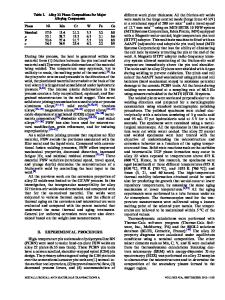Influence of the Friction Stir Welding-Traveling Speed on the Corrosion Properties of Mg-5Al Alloy
- PDF / 1,927,445 Bytes
- 10 Pages / 593.972 x 792 pts Page_size
- 91 Downloads / 344 Views
JMEPEG DOI: 10.1007/s11665-017-2803-7
Influence of the Friction Stir Welding-Traveling Speed on the Corrosion Properties of Mg-5Al Alloy B.X. Vuong, H.T. Anh, N.T. Nhan, H.H.M. Xuan, D.C. Nguyen, and N.D. Nam (Submitted December 9, 2016; in revised form April 15, 2017) A Mg-5Al alloy was processed using the friction stir welding (FSW) technique with traveling speeds ranging from 0 to 80 mm/min. The influence of the FSW-traveling speed on the prepared Mg-5Al alloy was examined using electrochemical and surface analysis techniques. The electrochemical tests revealed that an increasing FSW-traveling speed results in a significant improvement of the corrosion resistance, as characterized by the higher pitting potential and film and charge transfer resistances. The increased corrosion resistance was attributed to the enhanced refinement of the precipitates, grain refinement and increased homogeneity of the microstructure obtained with an increasing FSW-traveling speed. Keywords
alkaline corrosion, friction stir welding, intermetallic compounds, magnesium alloys
1. Introduction During the last few decades, rapid growth has occurred in the investigation and development of magnesium and its alloys in almost every type of industry. A wide range of applications make magnesium and its alloys an ideal material: These materials have the lowest density of all the structural metals, which is an advantage for applications requiring a lighter weight. Therefore, magnesium alloys have become one of the most significant types of alloys in the applications of aerospace, electronics and automobile industries (Ref 1-4) due to their lightweight, stiffness, resistance to heat/creeping, surface quality, energy absorption, high strength and rigidity along with an inherent electromagnetic interference shielding, durability, heat dissipation, full recycling ability and high fracture elongation (Ref 1, 2, 5-9). MgO and Mg(OH)2 passive films form on the surface of Mg and its alloys (Ref 10-14). However, MgO can easily form cracks and Mg(OH)2 can roll up due to residual stress (Ref 10, 11). Therefore, the composition and structure of the oxide/ hydroxide films are reinforced by the addition of an active metal such as aluminum or a heavy metal. The low hydrogen overvoltage renders heavy metals, such as Fe, Ni and Cu, highly deleterious. In addition, precipitates such as aluminumiron or nickel-magnesium compounds have been formed when iron or nickel was added to Mg alloys (Ref 15, 16). These precipitates act as local cathodes during alloy dissolution to B.X. Vuong, Department for Management of Science and Technology Development, Ton Duc Thang University, Ho Chi Minh City, Vietnam; and Faculty of Applied Sciences, Ton Duc Thang University, Ho Chi Minh City, Vietnam; H.T. Anh, Thu Dau Mot University, 6 Tran Van On Street, Phu Hoa Ward, Thu Dau Mot City, Binh Duong Province, Vietnam; and N.T. Nhan, H.H.M. Xuan, D.C. Nguyen, and N.D. Nam, PetroVietnam University, 762 Cach Mang Thang Tam Street, Long Toan Ward, Ba Ria City, Ba Ria-Vung Tau Province, Vietnam.
Data Loading...











